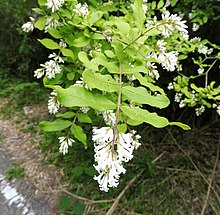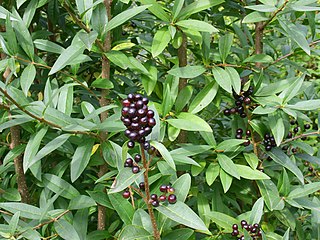
A privet is a flowering plant in the genus Ligustrum. The genus contains about 50 species of erect, deciduous or evergreen shrubs, sometimes forming small or medium-sized trees, native to Europe, north Africa, Asia, many introduced and naturalised in Australasia, where only one species, Ligustrum australianum, extends as a native into Queensland. Some species have become widely naturalized or invasive where introduced. Privet was originally the name for the European semi-evergreen shrub Ligustrum vulgare, and later also for the more reliably evergreen Ligustrum ovalifolium and its hybrid Ligustrum × ibolium used extensively for privacy hedging, though now the name is applied to all members of the genus. The generic name was applied by Pliny the Elder to L. vulgare. It is often suggested that the name privet is related to private, but the OED states that there is no evidence to support this.

Acer ginnala, the Amur maple, is a plant species with woody stems native to northeastern Asia from easternmost Mongolia east to Korea and Japan, and north to the Russian Far East in the Amur River valley. It is a small maple with deciduous leaves that is sometimes grown as a garden subject or boulevard tree.

Spiraea prunifolia, commonly called bridalwreath spirea, is a species of the genus Spiraea, sometimes also spelled Spirea. It flowers mid-spring, around May 5th, and is native to Japan, Korea, and China. It is sometimes cultivated as a garden plant elsewhere.

Vaccinium uliginosum is a Eurasian and North American flowering plant in the genus Vaccinium within the heath family.
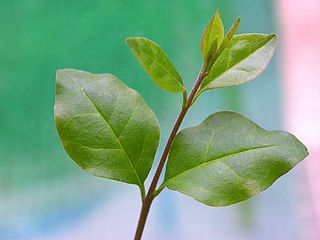
Ligustrum sinense is a species of privet native to China, Taiwan and Vietnam, and naturalized in Réunion, the Andaman Islands, Norfolk Island, Costa Rica, Honduras, PanamáLigustrum lucidum.

Ligustrum lucidum, the broad-leaf privet, Chinese privet, glossy privet, tree privet or wax-leaf privet, is a species of flowering plant in the olive family Oleaceae, native to the southern half of China and naturalized in many places. The name "Chinese privet" is also used for Ligustrum sinense.

Ligustrum ovalifolium, also known as Korean privet, California privet, garden privet, and oval-leaved privet, is a species of flowering plant in the olive family Oleaceae. The species is native to Japan and Korea.

Syringa reticulata, the Japanese tree lilac, is a species of flowering plant in the family Oleaceae native to eastern Asia, which is grown as an ornamental in Europe and North America.
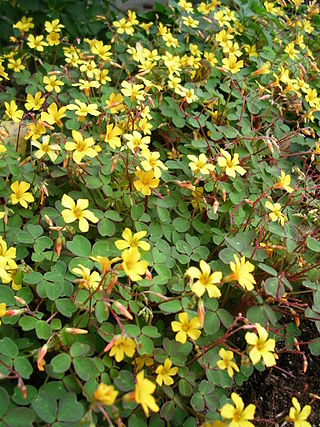
Oxalis spiralis, the spiral sorrel, is a species of plant of the genus Oxalis, a member of the wood sorrel family Oxalidaceae.

Sambucus racemosa is a species of elderberry known by the common names red elderberry and red-berried elder.

Sagittaria montevidensis is a species of flowering plant in the water-plantain family Alismataceae. Common names include giant arrowhead and California arrowhead.
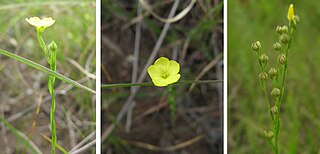
Linum medium, common name stiff yellow flax, is a species of Linum (flax) native to eastern North America. It is found as far west as Texas and Wisconsin, east to the Atlantic ocean, north to Ontario and Maine, and south to southern Florida. It is also found in The Bahamas.

Silene polypetala is a rare species of flowering plant in the family Caryophyllaceae known by the common names eastern fringed catchfly and fringed campion. It is native to Georgia and northern Florida in the United States. It is threatened by the loss and degradation of suitable habitat. It is a federally listed endangered species of the United States.

Echinocereus pentalophus, with the common name ladyfinger cactus, is a species of Echinocereus cactus, in the tribe Echinocereeae Tribe. It is native to North America.
Rorippa barbareifolia, the hoary yellowcress, is a plant species reported from Manchuria, Inner Mongolia, Mongolia, Siberia, Alaska, Yukon and Saskatchewan. It grows in wet habitats. It can be found along forest borders, in ditches, on stream banks, etc.
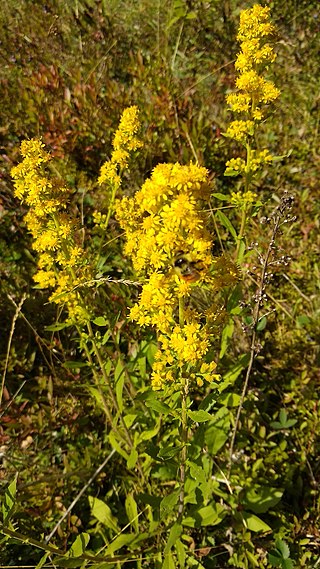
Solidago puberula, the downy goldenrod, is a plant species native to eastern North America from Nova Scotia and Ontario south to Florida and Louisiana. Two subspecies are commonly recognized:
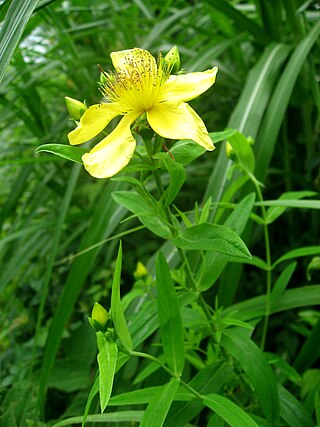
Hypericum ascyron, the great St. Johnswort or giant St. John's wort is a flowering plant in the family Hypericaceae.

Youngia japonica, commonly called Oriental false hawksbeard, is a species of flowering plant in the family Asteraceae. Native to eastern Asia, it is now found as a weed nearly worldwide.
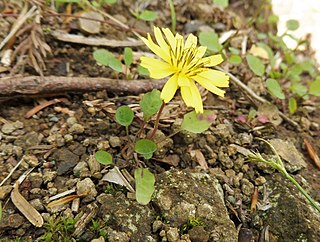
Ixeris stolonifera, commonly called creeping lettuce, is a species of flowering plant in the family Asteraceae. It is native to east Asia, where it is found in China, Japan, and Korea. It is a common and widespread species in Japan.
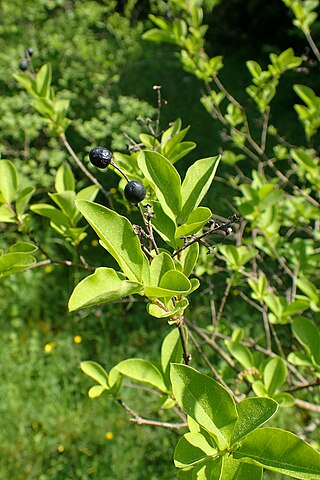
Ligustrum × ibolium, called the north privet or ibolium privet, is a hybrid species of flowering plant in the genus Ligustrum, the result of a cross between Ligustrum obtusifolium and Ligustrum ovalifolium. It is probably the most common privet used for hedging in the United States. It grows up to 1 m (3 ft) per year.
